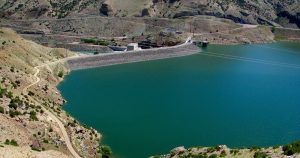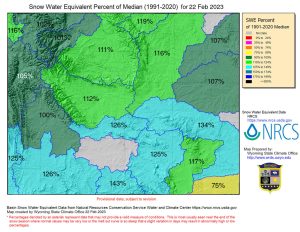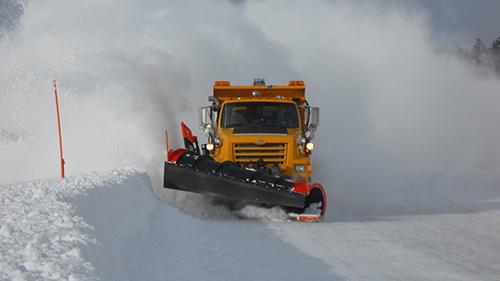Bighorn Basin’s Reservoir Forecast Still Looks Great After a Dry January
Written by Andrew-Rossi on February 22, 2023
A warm, dry January had an impact on the Bighorn Basin’s water, but there’s still plenty in the region’s four reservoirs – and even more to come after February’s winter storms.
The Bureau of Reclamation released its latest snowmelt forecast for 2023 on Tuesday, Feb. 21. Based on the latest numbers; it looks like there will be plenty of water and moisture throughout the region – the first time in several years all the reservoirs are at or near their full average capacity.
Each report calculates the spring runoff of each river in the Bighorn Basin to determine how full the basin’s reservoirs will be this summer. A reservoir is considered “full” when the pool elevation is at the top of active conservation or joint-use pool. The percentage is based on the total reservoir volume below that level.

Courtesy The Thermopolis Blogger
January was a mixed bag for the Bighorn Basin – forecasts for two reservoirs trickled down while the other two are brimming over.
Reclamation’s January forecast of the April through July runoff predicted for the Bighorn River Basin is as follows:
Bighorn Lake
- The April through July inflow to Bighorn Lake is forecast to be approximately 1,209,000 acre-feet (a.f.), which is 98% of the 30-year average of 1,235,000 a.f.
- As of February 1, Bighorn Lake is currently at 83% full.
Buffalo Bill Reservoir
- The April through July inflow to Buffalo Bill Reservoir from the Shoshone River is forecast at 670,000 a.f., which is 90% of the 30-year average of 748,300 a.f.
- As of February 1, Buffalo Bill is 72% full.
Boysen Reservoir
- April through July inflow to Boysen Reservoir is forecast at 800,000 a.f., which is 131% of the 30-year average of 611,000 a.f.
- As of February 1, Boysen Reservoir is 83% full.
Bull Lake Reservoir
- April through July snowmelt runoff into Bull Lake Reservoir from Bull Lake Creek is expected to be 170,000 a.f, which is 118% of the 30-year average of 144,200 a.f.
- As of February 1, Bull Lake Reservoir is 48% full.
The forecasts as of January 1 were 103%, 94%, 115%, and 104%, respectively.
Winter 2022-2023 has provided much-needed moisture to the entire region, making a long-term difference. Snowmelt inflow was below average in 2021 and 2022, although most reservoirs were full to brimming in 2020.
The latest report doesn’t account for the two significant snowstorms that buried the Bighorn Basin in several inches of snow, which means more water this summer.
Around ten inches of snow was reported in Thermopolis during the Feb. 14 snowstorm. It’s anticipated another ten inches will be reported by the end of the Feb. 22 snowstorm. This means a lot more moisture that will find its way into the Boysen Reservoir – which is already well above its average acre-feet.
However, the Buffalo Bill Reservoir and Bighorn Lake are currently predicted to be below their 30-year average.
The latest Bureau of Reclamation predictions corresponds with the snow-water equivalent the Wyoming Water Resources Data System & State Climate Office measured. As of Feb. 22, all of northwest Wyoming – and most of the state – has over 100% of its average snowpack.

Courtesy Wyoming
Water Resources Data System & State Climate Office

